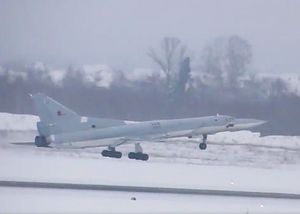The maiden flight of Russia’s upgraded Tupolev Tu-22M3M long-range strategic and maritime strike bomber took place on December 28, Russian aircraft maker, United Aircraft Corporation (UAC), announced in a statement.
“The first flight of the deeply modernized strategic bomber Tu-22M3M was held on the aerodrome of the Kazan Aircraft Association Production, Tupolev branch… the flight was at an altitude of 1,500 meters and lasted 37 minutes,” the statement reads.
“All tests concerning the verification of new onboard systems and equipment, installed in the context of extensive modernization, were completed during the flight. The flight team’s data shows that the flight proceeded as planned, systems and equipment were used without issue.”
According to a Russian defense industry source quoted by TASS news agency, the aircraft prototype was unarmed during its debut flight.
The first flight of the upgraded aircraft was initially scheduled for early October, but had to be postponed for technical reasons, although ground trials continued throughout that period. The first Tu-22M3M prototype was rolled out at a UAC plant in Kazan this August.
The Tu-22M3M bomber is a derivative of the Tu-22 supersonic variable-sweep wing bomber first introduced into service with the Soviet Air Force and Soviet Naval Aviation in the 1970s.
“In comparison to its immediate predecessor the Tu-22M3, the modernized Tu-22M3M will feature upgraded avionics, new digital radio-navigation equipment, and a new communications suite, next to a number of other improvements,” I explained previously. “Notably, unlike the upgraded Tu-160M2 long-range strategic bomber, the Tu-22M3M will not be fitted with a new engine.”
It remains unclear whether the upgraded bomber will also be fitted with an aerial refueling capability. (The in-flight refueling capability was removed from previous versions of the Tu-22M3M to comply with the original START.)
A possible New START treaty violation could emerge as a result of the bomber’s modernized weapon control system, which will enable the launch of precision-guided air-launched ballistic missiles and dual-capable air-launched cruise missiles in excess of 600 kilometers. This would risk the aircraft being classified as a heavy bomber. Notably, the Tu-22M3M will be capable of firing Kh-32 long-range cruise missiles, as I explained elsewhere
The Kh-32, an upgraded version of the Raguda Kh-22 long-range anti-ship missile, has been specifically designed to attack U.S. Navy carrier strike groups, but can also be used for land strike missions. It is reportedly designed to climb to the stratosphere (40 kilometers) after launch and then either directly dives at the target or executes a lighter dive and approaches the target flying close to the ground at around 150-200 meters. The K-32 purportedly has an operational range of 1,000 kilometers and can reach top speeds of over Mach 4 in its terminal phase.
The Tu-22M3M can also carry the Rhaduga Kh-15 aero-ballistic missile. The bomber will be capable of carrying up to three Kh-32 or 12 Kh-15 missiles. Both the Kh-15 and Kh-32 can alternatively be fitted with conventional or nuclear warheads.
Overall, the bomber can carry a weapons load of around 24 tons.
The new bomber is slated to enter service with the Russian Air Force by 2021. Russia plans to upgrade up to 30 Tu-22s to the more advanced Tu-22M3M variant.
































